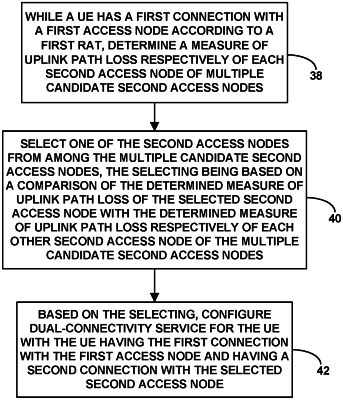| CPC H04W 76/16 (2018.02) [H04W 36/08 (2013.01); H04W 48/20 (2013.01); H04W 52/242 (2013.01); H04W 72/0473 (2013.01)] | 15 Claims |

|
1. A method for controlling service when a user equipment device (UE) is served concurrently (i) by a first access node in accordance with a first radio access technology (RAT) and (ii) by a second access node in accordance with a second RAT, the method comprising:
determining, by the UE, a first measure of uplink path loss of the first access node and a second measure of uplink path loss of the second access node, wherein determining the first measure of uplink path loss of the first access node and the second measure of uplink path loss of the second access node comprises receiving from the first access node a unicast message that specifies the uplink path loss of the first access node and the uplink path loss of the second access node;
comparing, by the UE, the determined first measure of uplink path loss of the first access node with the determined second measure of uplink path loss of the second access node;
based on the comparing, selecting, by the UE, between the first access node and the second access node as an access node through which to initiate a communication; and
initiating, by the UE, the communication through the selected access node rather than through the other access node of the first access node and the second access node.
|